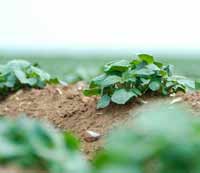Biofumigant mustard crop cuts potato cyst nematode population

Field-scale trials of a biofumigant mustard crop have given around 50% potato cyst nematode suppression, Andy Barker of Barworth Agriculture told growers.
PCN control had become more difficult, particularly since the suspension of use of the soil sterilant, Telone II, he noted.
So positive results from the use of a biofumigant crop were exciting, he said. “They aren’t an easy option, but my hope is that growers could start to use them as a standard approach within the rotation.”
In the trial, 3ha of Fumore 3, a blend of a “hot” mustard, ISCI99, radish and a white mustard, was planted in August and incorporated in early October, Dr Barker said.
“It wasn’t a great crop, reaching around 50-60t/ha of biomass, instead of the 80t/ha ideally I would have wanted to see, so I wasn’t expecting results as good as we achieved.”
Pre- and post-crop sampling of PCN by Richard Austin Associates found PCN levels in 1ha blocks decreased by 40-75%. “In another field we saw a 25% decline in egg numbers, but the crop was poorer.”
For best results he believes the crop has to be planted as soon as possible following a crop such as peas, winter barley or oilseed rape. “Ideally it needs to be drilled, not broadcast, before mid August.”
Getting the crop to enough biomass, flowering, while soil temperatures were high enough in the autumn was a challenge, he admitted. Incorporation had to be done in moist soils over 12C at mid-flowering to me most effective.
But over-wintering wasn’t really an option, he said. “Out of five crops we lost three to frost.”
Around 100kg/ha of nitrogen and 20kg/ha of sulphur were needed to grow the crop, which costs around £80/ha for the seed.
“But you get your money back on the fertiliser from the green manure value of the crop, and it also has positive benefits on soil structure.”
Biofumigant crops also had benefits against rhizoctonia, and other diseases such as fusarium and pythium, he suggested.
Trap crop alternative
An alternative option to biofumigant crops was using the trap crop, Solanum sisymbriifolium, sold by Branston as Foil-sis and Greenvale as DeCyst, he said.
One grower he knew was taking the potato field out of production the year before to plant the crop, which triggers PCN hatch but prevents the nematodes from completing their life cycle.
“He feels it is worth it on around 30-40ha each year, but it is probably a step too far for most growers.
“But I know of other growers who have found hot spots in fields that they have taken out of production for a year.”
